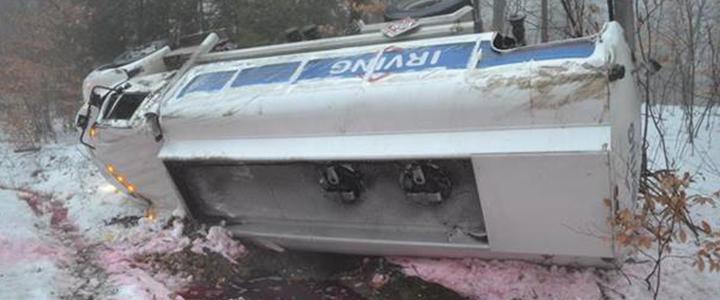
NHDES and USEPA Collaborate on Statewide Spill Risk Assessment
On January 9, 2014, 10,000 gallons of 4-methylcyclohexanemethanol (MCHM) and propylene glycol phenyl ether (PPH) were discharged from a chemical storage tank into the Elk River, the primary source of drinking water for Charleston, West Virginia. These chemicals quickly reached the intake for the city’s water treatment plant, causing officials to shut down the plant and prompting the Governor to declare a state of emergency. Approximately 300,000 people in the metropolitan area were without water for up to nine days, resulting in both a public health and economic crisis. Many questions remained unanswered in the ensuing hours after the spill due to a lack of available information about the chemicals released into the river, such as the substances’ toxicity, human health effects and why there was a long delay in notifying Charleston’s public water supplier. Additionally, the lack of analytical methods suitable for measuring these novel contaminants in drinking water complicated response efforts. Prior knowledge of chemicals stored up-river from Charleston’s intake would have allowed utility managers to assess the risk and prepare for a release before it occurred.
Following the Elk River contamination incident, Congress passed the America’s Water Infrastructure Act (AWIA) in 2018, which revised the Emergency Planning and Community Response Act (EPCRA). EPCRA now requires the state drinking water program or State Emergency Response Commission to provide emergency notification to community water systems when there is any reportable release of extremely hazardous substance (defined under EPCRA) or hazardous substance (defined under the Comprehensive Environmental Response, Compensation, and Liability Act (CERCLA), also known as Superfund) that may affect their source water. Also, Section 2018 of AWIA amended EPCRA to ensure community water systems have access to Tier II reports (for instance, hazardous chemical inventory data) sent to the state as required by EPCRA. Annual Tier II chemical inventory reporting is one of the most comprehensive listings of facilities that store hazardous chemicals. Furthermore, Tier II reports contain information about the identity and quantity of hazardous chemicals stored at the facility. These reports also contain both business and emergency contact information and, are among the most valuable resources for conducting source water contamination threat inventories.
Using Tier II data, and over 20 other state and federal data sets, NHDES’ Source Water Protection Program teamed up with USEPA’s Water Security Division and USEPA contractor Corona Environmental to build a statewide inventory of chemical storage facilities and accident-prone locations along roads, and assess the risk of a catastrophic release into source water used as a drinking water source. Specifically, the goal of this collaborative effort was to identify chemical storage facilities in source water protection areas that present a higher risk of human exposure and health impact should a catastrophic release of a hazardous substance occur. The primary factors considered in the spill risk assessment were acute human toxicity and volume of the stored chemical(s), travel time to an intake, peak concentration at an intake and the ability of conventional water treatment to remove the substance. Spill risk scores were calculated for each chemical storage site in the inventory; the scores were indexed and then grouped into risk categories (high, medium, low).
“While New Hampshire hasn’t experienced a
chemical spill that has affected or interrupted
surface water supplies, Elk River clearly demonstrated
the need for utility managers to receive timely
notification of spills and have access to information
that includes the chemical toxicity and potential human health impacts.This work, supported by NHDES and the USEPA,
provides drinking water utilities with valuable insight
to assess the risks that spilled or released substances pose to providing safe drinking water.”
– John Boisvert, P.E., Chief Engineer Pennichuck Water
Maps showing chemical storage sites and related information are now available to community water systems and first responders. Public water systems may incorporate the results of this work into risk and resilience assessments and emergency response plans required under Section 2013 of AWIA. The results of each water system’s source water contamination threat inventory and risk assessment could also be used for other activities, such as: conducting site visits or windshield surveys of high-risk facilities, conducting site-specific treatability studies for contaminants stored at high-risk facilities, establishing direct notification procedures for releases that occur at high-risk facilities, and identifying analytical methods and laboratories for contaminants stored at high-risk facilities. Contact Pierce Rigrod at (603) 271-0688 or pierce.laskey-rigrod@des.nh.gov for further information on obtaining maps and related informational products.




